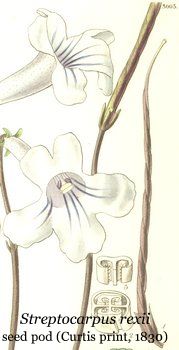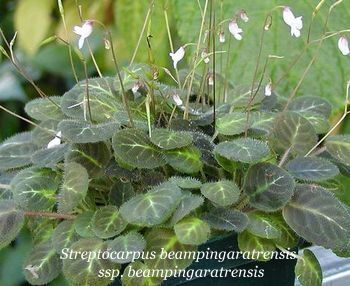 The genus Streptocarpus contains approximately 140 species most of which occur in Africa and Madagascar. The key feature of the genus Streptocarpus is that the seed capsule is twisted, whereby the name Streptocarpus (twisted fruit capsules) was derived. Some Asian genera of the Gesneriaceae such as Boea and allies also have twisted fruits so this is not an entirely distinguishing feature.
The genus Streptocarpus contains approximately 140 species most of which occur in Africa and Madagascar. The key feature of the genus Streptocarpus is that the seed capsule is twisted, whereby the name Streptocarpus (twisted fruit capsules) was derived. Some Asian genera of the Gesneriaceae such as Boea and allies also have twisted fruits so this is not an entirely distinguishing feature.
Initial studies indicated that the classification of the genus into the subgenera Streptocarpus and Streptocarpella was correct until a number of Madagascan species were described which seemed to indicate that the genus may have been a lot closer to the genus Saintpaulia than originally thought. Hilliard and Burtt indicated that the discoveries by Humbert of herbaceous species with very short stems and leaves arising from a short stalk reminded one of the genus Saintpaulia.
 This initial observation has now been supported by a molecular study using nuclear DNA (so-called ITS sequences) in which it has been shown that the genus Saintpaulia evolved from the subgenus Streptocarpella (2). The subgenus Streptocarpella can furthermore be divided phylogenetically into the African mainland species and the Madagascan species, with the genus Saintpaulia as a third clear phylogenetic entity within this subgenus. Whether the genus Saintpaulia will be drawn into Streptocarpella or vice versa, or each left as separate taxons, I will leave to the taxonomists.
This initial observation has now been supported by a molecular study using nuclear DNA (so-called ITS sequences) in which it has been shown that the genus Saintpaulia evolved from the subgenus Streptocarpella (2). The subgenus Streptocarpella can furthermore be divided phylogenetically into the African mainland species and the Madagascan species, with the genus Saintpaulia as a third clear phylogenetic entity within this subgenus. Whether the genus Saintpaulia will be drawn into Streptocarpella or vice versa, or each left as separate taxons, I will leave to the taxonomists.
The molecular phylogenetic study was furthermore able to show that the unifoliate species and the rosulate species of the subgenus Streptocarpus occur as a mixed group and that unifoliate species have arisen out of rosulate species and vice versa a number of times. Most of the rosulate hybrids were developed from the species occurring in eastern South Africa in a group of species referred to as the Cape Primrose clade.
